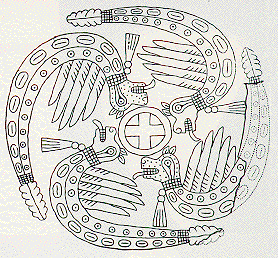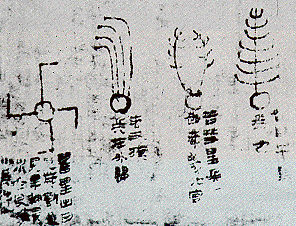
The Swastika did NOT originate as a Nazi symbol of hatred. SWASTIKA is derived from the Sanskrit word: SVASTIKAH, which means 'being fortunate'.

even in his grave. Don't believe his BIG LIE about the swastika.
an ancient symbol of good luck, prosperity, and long life, used not only in Mississippian burial mounds but also in even more ancient cultures such as India and China.

The silk was discovered during the 1970s at Mawangdui, near Changsa, in Number Three Tomb. There were 29 comets illustrated on the silk, of which the last 4 are shown above. As you can see, the last comet, on the far left, is illustrated by a Swastika. Sagan and Druyan, in their book "Comet" (Random House 1985), p. 186, say "The twenty-ninth comet is called 'Di-Xing', 'the long-tailed pheasant star'." As a comet form, the Swastika looks like a spinning comet from which jets are erupting, like Comet Hale-Bopp.
The English and German word SWASTIKA is derived from the Sanskrit word: SVASTIKAH, which means 'being fortunate'. The first part of the word, SVASTI-, can be divided into two parts: SU- 'good; well', and -ASTI- 'is'. The -ASTIKAH part just means 'being'.
The word is associated with auspicious things in India - - because it means 'auspicious'. About 2500 years ago, when Sakyumuni brought Buddhism to China from India, the Chinese also borrowed the swastika and its sense of auspiciousness.
In China, the swastika is a Chinese character ( Pinyin wan4, \
tone ) which means "ten thousand, a very great number, myriad". As
shown on a
Chinese Character Dictionary web page, that swastika character
![]() can be simplified to
can be simplified to ![]() and also can be written traditionally as
and also can be written traditionally as ![]() .
.
The swastika symbol has been used for thousands of years among practically every group of humans on the planet. According to Barbara G. Walker, in The Woman's Encyclopedia of Myths and Secrets:
"... Swastikas appear on Paleolitic carvings on mammoth ivory from the Ukraine, dated ca. 10,000 B.C. Swastikas figure on the oldest coinage in India. Persia, Asia Mior, and Greece represented the rotating axis mundi with the symbol of a swastika. On a Boeotian amphora of the 7th century B.C., the swastika was presented as a sacred sign of the Goddess Artemis. It also represented many other deities from Iceland to Japan, Scandinavia to North Africa. It was much used in Troy and Mycenaie before the 13th century B.C. ... In Japan, the reborn Amida, "Buddha of Immeasurable Light", wore a left-handed swastika carved on his breast. A similar left-handed swastika was the sign of Thor's hammer on Scandinavian coins. ... Trojan images of the Great Goddess showed a swastika within a female triangle on her belly, indicating the hidden god prior to his next rebirth. Early Chiristians adopted the swastika to represent Christ, calling it a crux dissimulata or disguised cross. It was also called the crux gammata ... because it showed the Greek letter gamma four times repeated. To Saxons it was fylfot, translated either "four-foot", referring to the four heavenly pillars at the corners of the earth, or "fill-foot", referring to the Christian habit of filling in the foot of a church window with swastikas. ...... A variant of the swastika [eight-armed double swastika] ... represented German Vehmic Courts (from Vehme, "punishment") which began in the Middle Ages as civil tribunals for persecuting heretics, and became connected with the Inquisition. ... From the Vehmgericht arose specifically anti-Semitic secret societies of Austria and Germany in the early 1900s - the forerunners of Nazism. ...".
As the "Cross of Thor", the symbol was even brought to England by Scandinavian settlers in Lincolnshire and Yorkshire, long before Hitler.
It is interesting that the Nazis did not use the term "Cross of Thor", which is consistent with German history, but instead preferred to steal the Indian term "swastika.
It is even more interesting that the swastika has been found on Jewish temples from 2000 years ago in Palestine, so Hitler was (inadvertently?) stealing a Jewish symbol as well as an Indian one.
In the Americas, the swastika was used by Native Americans in North, Central, and South America. According to Barbara G. Walker, in The Woman's Encyclopedia of Symbols and Sacred Objects:
"...[The]... rattlesnake swastika design from a Mississippian Indian burial mound ...[]... Around a solar cross lie four spirit-rattlesnakes, having not only rattles on their tails but also strange doglike faces, mouselike ears, humanlike teeth, and stylized wings. These were connected with the winged or feathered serpent deities of Mexico and Central America. ...".
Since the outer arms of the swastika can point either counterclockwise or clockwise, the swastika has been used as a counterpart to the Taiji, or Yin-Yang, symbol.
Taiji in red and black  are commonly used with respect to the Tao
.
are commonly used with respect to the Tao
.
In India, both clockwise and counterclockwise swastikas were used, with different meanings: the counterclockwise one is associated with the goddess Kali-Maya (mother of Buddha, associated with the Moon), and the clockwise one is associated with Ganesha (elephant-headed father of Buddha, associated with the Sun).
Barbara G. Walker, THE WOMAN'S ENCYCLOPEDIA OF MYTHS AND SECRETS (1983), and THE WOMAN'S DICTIONARY OF SYMBOLS & SACRED OBJECTS (1988), both published by Harper & Row;
James A. Michener, THE SOURCE;
Ernest Klein, KLEIN'S COMPREHENSIVE ETYMOLOGICAL DICTIONARY OF THE ENGLISH LANGUAGE (Elsevier, 1971);
Robert H. Mathews, MATHEWS' CHINESE-ENGLISH DICTIONARY (Harvard, 1966).
A Modern Chinese-English Dictionary, Duan Shizen, Chief Editor (Oxford University Press, 1989).
The book "In Search of the Cradle of Civilization" by Georg Feuerstein, Subhash Kak, and David Frawley (Quest 1995) describes the history of India from a perspective different from that of English colonialists.
According to Joe Hofler, who also refers to Dr. Kumbari of the museum of Urimqi in Xinjiang, China, the Indo-Aryans of the Germanic branch traveled into Europe around 2000 BC and brought with them the"svastika" symbol (sun disk) of their religious art at that time as shown by excavations of Kurgan graves on the steppes of Russia and Indo-Aryan graves in Xinjiang, China.
......